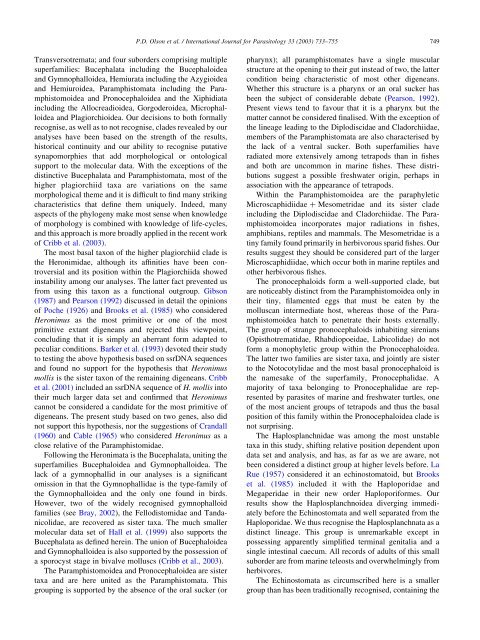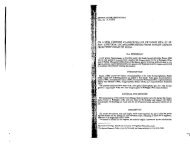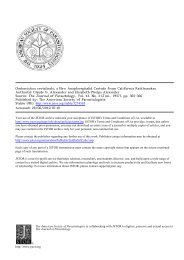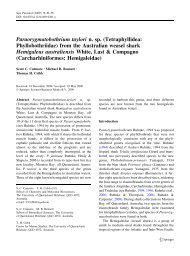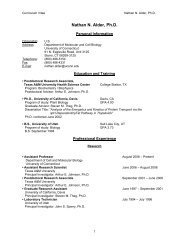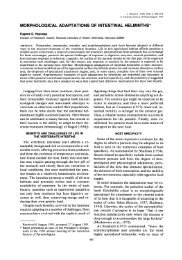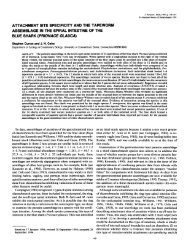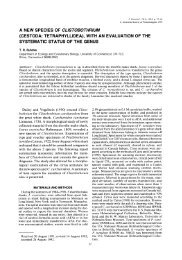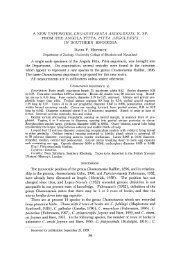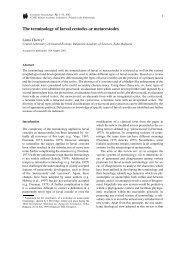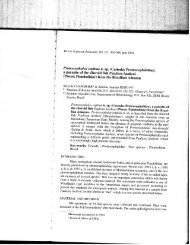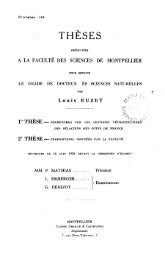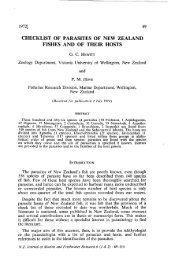Phylogeny and classification of the Digenea (Platyhelminthes ...
Phylogeny and classification of the Digenea (Platyhelminthes ...
Phylogeny and classification of the Digenea (Platyhelminthes ...
You also want an ePaper? Increase the reach of your titles
YUMPU automatically turns print PDFs into web optimized ePapers that Google loves.
P.D. Olson et al. / International Journal for Parasitology 33 (2003) 733–755 749Transversotremata; <strong>and</strong> four suborders comprising multiplesuperfamilies: Bucephalata including <strong>the</strong> Bucephaloidea<strong>and</strong> Gymnophalloidea, Hemiurata including <strong>the</strong> Azygioidea<strong>and</strong> Hemiuroidea, Paramphistomata including <strong>the</strong> Paramphistomoidea<strong>and</strong> Pronocephaloidea <strong>and</strong> <strong>the</strong> Xiphidiataincluding <strong>the</strong> Allocreadioidea, Gorgoderoidea, Microphalloidea<strong>and</strong> Plagiorchioidea. Our decisions to both formallyrecognise, as well as to not recognise, clades revealed by ouranalyses have been based on <strong>the</strong> strength <strong>of</strong> <strong>the</strong> results,historical continuity <strong>and</strong> our ability to recognise putativesynapomorphies that add morphological or ontologicalsupport to <strong>the</strong> molecular data. With <strong>the</strong> exceptions <strong>of</strong> <strong>the</strong>distinctive Bucephalata <strong>and</strong> Paramphistomata, most <strong>of</strong> <strong>the</strong>higher plagiorchiid taxa are variations on <strong>the</strong> samemorphological <strong>the</strong>me <strong>and</strong> it is difficult to find many strikingcharacteristics that define <strong>the</strong>m uniquely. Indeed, manyaspects <strong>of</strong> <strong>the</strong> phylogeny make most sense when knowledge<strong>of</strong> morphology is combined with knowledge <strong>of</strong> life-cycles,<strong>and</strong> this approach is more broadly applied in <strong>the</strong> recent work<strong>of</strong> Cribb et al. (2003).The most basal taxon <strong>of</strong> <strong>the</strong> higher plagiorchiid clade is<strong>the</strong> Heronimidae, although its affinities have been controversial<strong>and</strong> its position within <strong>the</strong> Plagiorchiida showedinstability among our analyses. The latter fact prevented usfrom using this taxon as a functional outgroup. Gibson(1987) <strong>and</strong> Pearson (1992) discussed in detail <strong>the</strong> opinions<strong>of</strong> Poche (1926) <strong>and</strong> Brooks et al. (1985) who consideredHeronimus as <strong>the</strong> most primitive or one <strong>of</strong> <strong>the</strong> mostprimitive extant digeneans <strong>and</strong> rejected this viewpoint,concluding that it is simply an aberrant form adapted topeculiar conditions. Barker et al. (1993) devoted <strong>the</strong>ir studyto testing <strong>the</strong> above hypo<strong>the</strong>sis based on ssrDNA sequences<strong>and</strong> found no support for <strong>the</strong> hypo<strong>the</strong>sis that Heronimusmollis is <strong>the</strong> sister taxon <strong>of</strong> <strong>the</strong> remaining digeneans. Cribbet al. (2001) included an ssrDNA sequence <strong>of</strong> H. mollis into<strong>the</strong>ir much larger data set <strong>and</strong> confirmed that Heronimuscannot be considered a c<strong>and</strong>idate for <strong>the</strong> most primitive <strong>of</strong>digeneans. The present study based on two genes, also didnot support this hypo<strong>the</strong>sis, nor <strong>the</strong> suggestions <strong>of</strong> Cr<strong>and</strong>all(1960) <strong>and</strong> Cable (1965) who considered Heronimus as aclose relative <strong>of</strong> <strong>the</strong> Paramphistomidae.Following <strong>the</strong> Heronimata is <strong>the</strong> Bucephalata, uniting <strong>the</strong>superfamilies Bucephaloidea <strong>and</strong> Gymnophalloidea. Thelack <strong>of</strong> a gymnophallid in our analyses is a significantomission in that <strong>the</strong> Gymnophallidae is <strong>the</strong> type-family <strong>of</strong><strong>the</strong> Gymnophalloidea <strong>and</strong> <strong>the</strong> only one found in birds.However, two <strong>of</strong> <strong>the</strong> widely recognised gymnophalloidfamilies (see Bray, 2002), <strong>the</strong> Fellodistomidae <strong>and</strong> T<strong>and</strong>anicolidae,are recovered as sister taxa. The much smallermolecular data set <strong>of</strong> Hall et al. (1999) also supports <strong>the</strong>Bucephalata as defined herein. The union <strong>of</strong> Bucephaloidea<strong>and</strong> Gymnophalloidea is also supported by <strong>the</strong> possession <strong>of</strong>a sporocyst stage in bivalve molluscs (Cribb et al., 2003).The Paramphistomoidea <strong>and</strong> Pronocephaloidea are sistertaxa <strong>and</strong> are here united as <strong>the</strong> Paramphistomata. Thisgrouping is supported by <strong>the</strong> absence <strong>of</strong> <strong>the</strong> oral sucker (orpharynx); all paramphistomates have a single muscularstructure at <strong>the</strong> opening to <strong>the</strong>ir gut instead <strong>of</strong> two, <strong>the</strong> lattercondition being characteristic <strong>of</strong> most o<strong>the</strong>r digeneans.Whe<strong>the</strong>r this structure is a pharynx or an oral sucker hasbeen <strong>the</strong> subject <strong>of</strong> considerable debate (Pearson, 1992).Present views tend to favour that it is a pharynx but <strong>the</strong>matter cannot be considered finalised. With <strong>the</strong> exception <strong>of</strong><strong>the</strong> lineage leading to <strong>the</strong> Diplodiscidae <strong>and</strong> Cladorchiidae,members <strong>of</strong> <strong>the</strong> Paramphistomata are also characterised by<strong>the</strong> lack <strong>of</strong> a ventral sucker. Both superfamilies haveradiated more extensively among tetrapods than in fishes<strong>and</strong> both are uncommon in marine fishes. These distributionssuggest a possible freshwater origin, perhaps inassociation with <strong>the</strong> appearance <strong>of</strong> tetrapods.Within <strong>the</strong> Paramphistomoidea are <strong>the</strong> paraphyleticMicroscaphidiidae þ Mesometridae <strong>and</strong> its sister cladeincluding <strong>the</strong> Diplodiscidae <strong>and</strong> Cladorchiidae. The Paramphistomoideaincorporates major radiations in fishes,amphibians, reptiles <strong>and</strong> mammals. The Mesometridae is atiny family found primarily in herbivorous sparid fishes. Ourresults suggest <strong>the</strong>y should be considered part <strong>of</strong> <strong>the</strong> largerMicroscaphidiidae, which occur both in marine reptiles <strong>and</strong>o<strong>the</strong>r herbivorous fishes.The pronocephaloids form a well-supported clade, butare noticeably distinct from <strong>the</strong> Paramphistomoidea only in<strong>the</strong>ir tiny, filamented eggs that must be eaten by <strong>the</strong>molluscan intermediate host, whereas those <strong>of</strong> <strong>the</strong> Paramphistomoideahatch to penetrate <strong>the</strong>ir hosts externally.The group <strong>of</strong> strange pronocephaloids inhabiting sirenians(Opisthotrematidae, Rhabdiopoeidae, Labicolidae) do notform a monophyletic group within <strong>the</strong> Pronocephaloidea.The latter two families are sister taxa, <strong>and</strong> jointly are sisterto <strong>the</strong> Notocotylidae <strong>and</strong> <strong>the</strong> most basal pronocephaloid is<strong>the</strong> namesake <strong>of</strong> <strong>the</strong> superfamily, Pronocephalidae. Amajority <strong>of</strong> taxa belonging to Pronocephalidae are representedby parasites <strong>of</strong> marine <strong>and</strong> freshwater turtles, one<strong>of</strong> <strong>the</strong> most ancient groups <strong>of</strong> tetrapods <strong>and</strong> thus <strong>the</strong> basalposition <strong>of</strong> this family within <strong>the</strong> Pronocephaloidea clade isnot surprising.The Haplosplanchnidae was among <strong>the</strong> most unstabletaxa in this study, shifting relative position dependent upondata set <strong>and</strong> analysis, <strong>and</strong> has, as far as we are aware, notbeen considered a distinct group at higher levels before. LaRue (1957) considered it an echinostomatoid, but Brookset al. (1985) included it with <strong>the</strong> Haploporidae <strong>and</strong>Megaperidae in <strong>the</strong>ir new order Haploporiformes. Ourresults show <strong>the</strong> Haplosplanchnoidea diverging immediatelybefore <strong>the</strong> Echinostomata <strong>and</strong> well separated from <strong>the</strong>Haploporidae. We thus recognise <strong>the</strong> Haplosplanchnata as adistinct lineage. This group is unremarkable except inpossessing apparently simplified terminal genitalia <strong>and</strong> asingle intestinal caecum. All records <strong>of</strong> adults <strong>of</strong> this smallsuborder are from marine teleosts <strong>and</strong> overwhelmingly fromherbivores.The Echinostomata as circumscribed here is a smallergroup than has been traditionally recognised, containing <strong>the</strong>


